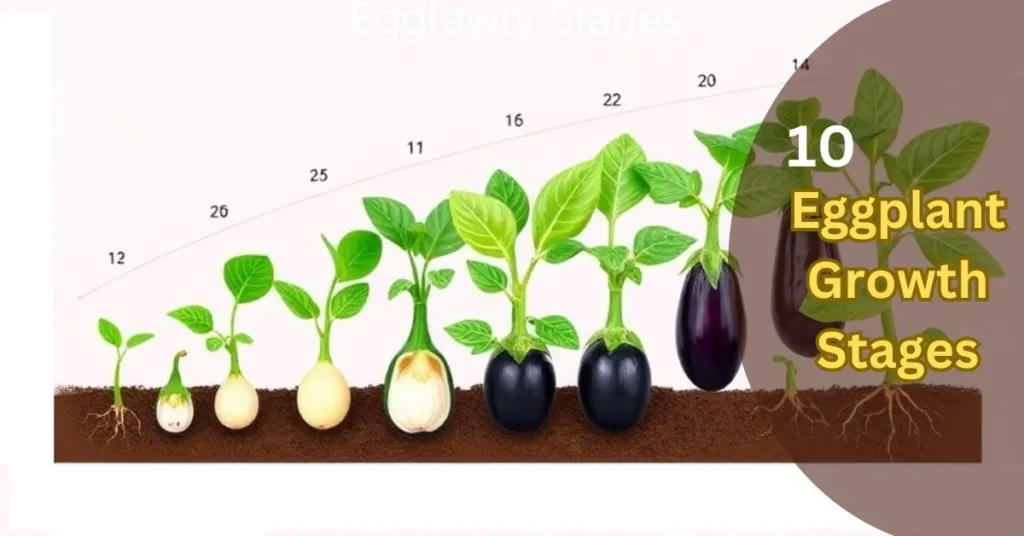When deciding between Vinca and Impatiens, it’s important to consider their unique growing conditions. Vinca is an excellent choice for sunny spots in your garden, thriving in hot, dry weather. It’s incredibly easy to care for and requires minimal attention, making it ideal for low-maintenance gardens.
On the other hand, Impatiens are perfect for areas that don’t receive much sun. They flourish in shady spots, where their vibrant and lush color can really stand out, especially in cooler areas.
While both plants bring beauty to your garden, they have distinct needs. If you’re working with a sun-drenched patch, Vinca will grow and bloom with ease.
If your garden is cooler or has more shade, Impatiens will thrive, adding a burst of color to those hidden corners. Even though they may seem similar, their ability to handle different weather conditions makes them perfect for various garden settings.
Key Points
| #- | Feature | Vinca | Impatiens |
|---|---|---|---|
| 1- | Plant Type | Perennial (Vinca minor and Vinca major) | Annual |
| 2- | Sunlight Requirements | Prefers full sun | Prefers partial to full shade |
| 3- | Water Needs | Moderate, drought-tolerant | Requires consistent watering |
| 4- | Flowering Season | Summer to fall | Spring to frost |
| 5- | Common Names | Vinca, Periwinkle | Impatiens, Jewelweed, Touch-me-not, Snapweed |
| 6- | Growth Habit | Ground cover, mounding | Bushy, compact plant |
| 7- | Color Options | Purple, blue, pink, white | Red, pink, white, purple, violet |
| 8- | Size | Smaller (for ground cover) to medium | Medium-sized bushy plants |
| 9- | Cold Resistance | Tolerates cold, but may stop flowering in frost | Sensitive to cold, stops growing in frost |
| 10- | Maintenance | Low maintenance, but invasive in some areas | Regular maintenance needed, especially in terms of pruning |
| 11- | Ideal for | Ground covers, hanging baskets, containers | Flower beds, hanging baskets, borders |
| 12- | Pest & Disease Resistance | Resistant to most pests and diseases | Can be prone to diseases like downy mildew |
| 13 | Soil Type | Well-drained, tolerant of poor soil | Prefers rich, moist, well-drained soil |
Vinca vs Impatiens: 5 Key Differences
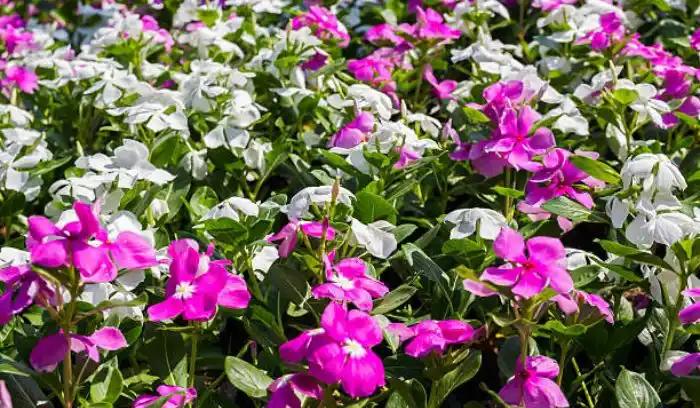
When deciding between Vinca and Impatiens, you should consider the environment in which they will grow. Vinca is known for being hardy and sun-loving, making it perfect for those sunny spots in your colorful garden. It’s also an easy care plant, requiring less attention compared to Impatiens.
On the other hand, Impatiens thrive in shady areas, offering a vibrant burst of color in cooler, less sunny locations. If you’re someone who can provide a bit more attention, Impatiens will reward you with their beautiful blooms.
Choosing the right one really depends on where you’re planting. Vinca is a great choice for sunny areas, while Impatiens are perfect for those shaded corners. Both are great choices for different reasons, so think about the conditions in your garden before making a decision. The right plant will make all the difference, whether it’s a sunny patch or a cool, shaded corner.
1. Appearance
| Feature | Vinca | Impatiens |
|---|---|---|
| Flowers | Simple flowers with five petals, often showing a darker center. | Brightly colored, delicate flowers with a multi-petal look |
| Foliage | Glossy, oval-shaped leaves that give a shiny finish | Soft, rounded leaves with a matte finish |
| Colors | Pink, white, red, purple, lavender | Wide range of colors including pink, red, white, orange, violet, and bi-colors |
| Growth Habit | Upright or spreading, growing 6–18 inches tall | Compact, bushy plants, reaching 6–24 inches tall |
| Appearance | Bold and shiny, perfect for making a statement | Soft and colorful, ideal for a gentle touch in the garden |
| Best for | Sunny areas, hot, dry weather | Shady spots, ideal for cooler, shaded areas |
| Care Requirements | Easy care, drought-tolerant, needs less attention | Requires more attention, thrives in moist soil and cooler conditions |
| Plant Type | Perennial in warmer climates, low-maintenance | Annual in most climates, thrives with regular watering |
| Bloom Duration | Blooms last longer throughout the summer | Blooms for a shorter period but provides vibrant color |
| Ideal Garden Use | Ideal for creating a bold, shiny effect in sunny gardens | Adds colorful accents in shaded garden areas, ideal for filling gaps |
Vinca
Vinca is a popular plant known for its simple flowers that have five flat petals and often feature a darker center, making them stand out in any garden. It comes in various colors like pink, white, red, purple, and lavender, adding beauty to your garden.
The plant has shiny, oval-shaped leaves with a smooth texture, creating a tidy and polished look. Whether it grows upright or spreads, Vinca can reach a height of 6 to 18 inches tall, making it ideal for garden borders and sunny spots.
Not only is Vinca a beautiful addition to any garden, but it’s also a low-maintenance, tidy plant that requires little attention. Its bold colors and polished look add a touch of elegance, perfect for those looking for a simple yet striking plant. With its versatility and ease of care, Vinca is the perfect choice for any gardener wanting to create a vibrant and organized garden space.
Impatiens
Impatiens are a great choice for those looking to add vibrant color to their garden. These plants feature fuller flowers with multiple petals, giving them a lush and delicate appearance.
The soft, rounded leaves have a matte finish, creating a relaxed and gentle appearance that makes them stand out in shady corners or under trees. If you want a softer, more colorful garden, Impatiens might be the perfect addition.
These plants are typically bushy and compact, growing between 6 to 24 inches tall, depending on the type.
Their ability to thrive in shaded areas makes them ideal for filling spaces that receive less sunlight, all while adding a pop of color to otherwise dull spots. Whether used under trees or in shady corners, Impatiens bring a touch of softness and brightness to your garden.
2. Growing Conditions
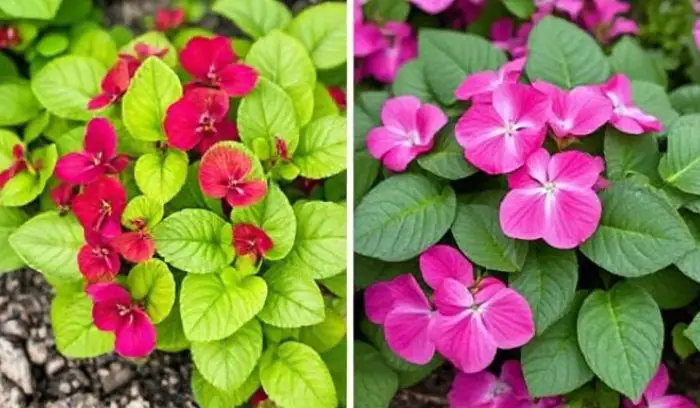
| Feature | Vinca | Impatiens |
|---|---|---|
| Sunlight | Full sun, partial shade | Prefers partial shade to full shade |
| Soil | Poor, sandy, well-draining | Rich, moist, well-draining |
| Watering | Drought-tolerant | Requires consistent moisture |
| Hardiness | Heat-tolerant | Sensitive to heat, needs cooler conditions |
| Best Growing Conditions | Full sun, can tolerate dry | Needs cooler conditions with moist soil |
Vinca
Vinca is a plant that does exceptionally well in sunny spots. It thrives in full sun but can also handle some partial shade. If you have poor soil, Vinca will still do great, as it’s fine with sandy or rocky soil, as long as the soil drains well.
One of the best things about Vinca is that it doesn’t need much water. It’s very drought-tolerant, meaning you only need to water it when the soil is dry, making it a perfect choice for gardeners who might not have the time to water plants regularly.
Additionally, Vinca loves the heat. Even on the hottest days, it continues blooming and looking great, making it a reliable and low-maintenance plant for sunny areas. Its ability to handle dry conditions and thrive without much care makes Vinca an excellent option for gardens that are exposed to intense sun and heat.
Impatiens
Impatiens thrive in cool, shady spots and do not enjoy direct sunlight. If exposed to too much sun, they may wilt and struggle in extreme heat. These plants require more attention when it comes to watering. The soil should remain damp, especially during warm days, as they can easily droop if the soil dries out too much.
Unlike other plants, Impatiens don’t handle hot areas well, so it’s essential to keep them well-watered and in shade to ensure they stay healthy and vibrant. If you’re planning to grow Impatiens, be prepared to give them the proper care and conditions they need to thrive.
Maintenance
| Feature | Vinca | Impatiens |
|---|---|---|
| Deadheading | Not necessary, self-cleaning | Not necessary |
| Pest Resistance | Generally pest-resistant | Vulnerable to downy mildew, aphids |
| Fertilizer | Minimal feeding | Needs regular feeding with balanced fertilizer |
| Care | Easy | Extra work |
| Reward | Blooms with little maintenance | Beautiful flowers with effort |
Vinca
Vinca is known for being low-maintenance, making it an ideal plant for busy gardeners. Unlike many other plants, deadheading (removing old flowers) is not necessary for Vinca because it cleans itself. The old flowers simply fall off on their own, reducing the need for regular maintenance. This plant is also resistant to most pests and bugs, so you don’t need to worry about insects damaging it.
When it comes to fertilizer, Vinca doesn’t need much. A light feeding once a month with a general-purpose fertilizer is enough to keep it healthy. After planting, it’s a “set it and forget it” kind of plant, which means you can enjoy its beauty with minimal effort.
Impatiens
Caring for Impatiens requires some attention and extra care, especially when it comes to preventing pests and managing diseases like downy mildew. These flowering plants tend to attract aphids, so it’s crucial to keep a close eye on them for any signs of trouble.
Regular feeding, using a balanced fertilizer, is key to ensuring healthy growth and vibrant, colorful flowers. If you act quickly when problems arise and focus on pest management, you’ll enjoy beautiful blooms throughout the season. In my experience, timely care is the best way to keep your Impatiens looking their best.
It’s also important to follow a feeding schedule and regular feeding to maintain healthy plants. Plant maintenance and flowers care are essential to prevent any health issues.
If you dedicate extra time to proper care and ensure mildew prevention, your Impatiens will flourish. Don’t forget to deadhead them to encourage more blooms and a tidier appearance. With the right attention to details, the reward of thriving, healthy flowering plants is truly worth the effort.
Uses in Landscaping
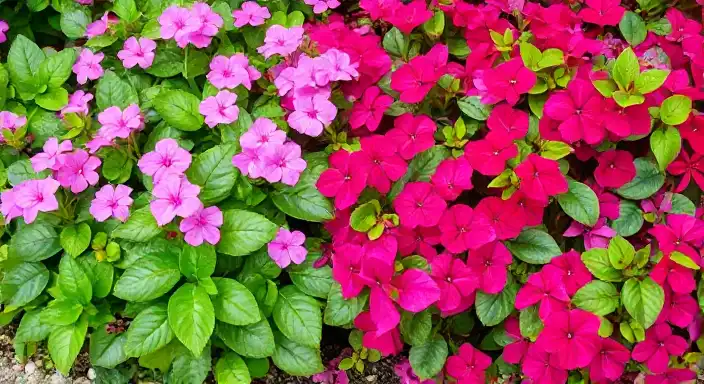
| Feature | Vinca | Impatiens |
|---|---|---|
| Best for | Hot, sunny areas, drought-prone gardens | Shady garden beds, borders, containers |
| Seasonal Appeal | Continuous blooms in summer and early fall | Continuous blooms in spring and summer |
| Key Characteristics | Thrives in sunny spots, perfect for borders and containers | Ideal for shady corners and garden beds |
| Color | Provides vibrant color in sunny areas | Brings color to shady spots |
| Growth Areas | Shines in hot, sunny areas | Shines in shady areas |
Vinca
Vinca is a great plant choice for hot and dry areas where many other plants may struggle to grow. This hardy plant thrives in sunny spots and is perfect for creating garden borders or filling up rock gardens.
Its spreading habit makes it an excellent option for ground cover, as it fills empty spaces while also adding a burst of color with its bright flowers. From my experience, planting Vinca in areas that receive full sun brings life to even the driest spots in your garden, making it both a beautiful and practical choice.
In addition to its vibrant appeal, Vinca works well as a low-maintenance solution for landscaping, especially in regions where water conservation is important. Its ability to thrive in dry areas makes it perfect for gardens that need plants that won’t require too much attention, allowing you to enjoy its color without worrying about frequent watering.
Impatiens
When you’re working with shady areas in your garden, Impatiens are the best choice to add color and life. These plants thrive in places where the sun doesn’t reach much, such as under trees or along shaded pathways.
I’ve found that they do wonders in those hard-to-grow spots where other plants might struggle. Their vibrant flowers can really brighten up a spot that feels dull or dark.
What’s more, their bushy growth makes them perfect for adding to pots or window boxes. They thrive in areas with limited sunlight, making them an ideal addition to shaded corners of your garden or even indoors. From my experience, planting Impatiens in these spaces can bring a touch of charm and color where it’s needed the most.
Tolerance
| Tolerance Factor | Vinca | Impatiens |
|---|---|---|
| Light Requirement | Does well in sunny areas | Thrives in shaded areas |
| Watering Needs | Tolerates dry conditions | Requires more water |
| Disease Resistance | More resistant to disease | Susceptible to downy mildew |
| Temperature Tolerance | Thrives in hot climates | Struggles in extreme heat |
| General Characteristics | Tough, can handle less care | Delicate, requires more pampering |
Vinca
Vinca is one of the hardiest plants around. It can handle almost anything, thriving in full sun with minimal care. One of its great features is that it doesn’t need much water, making it perfect for low-maintenance gardens.
It’s also resistant to many pests and diseases, so you don’t have to worry about it getting sick. I’ve personally seen Vinca continue blooming even during hot weather, which makes it a reliable choice for sunny garden spots.
What really sets Vinca apart is its ability to keep going even in tough conditions. Whether you’re dealing with heat or dry soil, it continues to bloom without skipping a beat. From my experience, this plant is ideal for those who want beauty in their garden but don’t have time for constant care.
Impatiens
Impatiens are a more sensitive plant compared to others, and they need the right environment to thrive. These plants require shade and cannot handle much heat. If exposed to too much sun or dry conditions, they may struggle.
Consistent watering is essential for Impatiens as they do not like dry soil. From my own experience, I’ve noticed that they flourish best in areas with humid conditions, but they are more vulnerable to diseases like downy mildew in such environments.
While they are beautiful and vibrant, Impatiens need a bit more care than other plants. Keeping them hydrated and away from extreme temperatures helps them grow well. If you live in a place with hot or dry climates, it’s important to monitor them closely to avoid damage from the elements or pests.
See Also:
Hibiscus Bush vs Tree: Which is Best for Your Garden?
The Ultimate Guide To Kumquat Vs Loquat: A Comprehensive Comparison
Peony vs Azalea: Which Plant is Best for Your Garden?
Vinca vs Impatiens: Which is better?
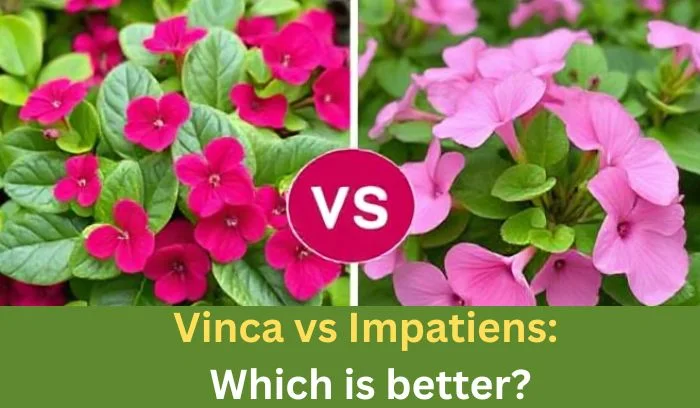
When it comes to choosing between Vinca and Impatiens, it all depends on your garden’s needs. If you have a hot, sunny spot that’s hard to keep watered, Vinca is your best choice. This hardy plant thrives in dry, hot locations and requires minimal maintenance.
On the other hand, if you have a shady area where other plants struggle, Impatiens will brighten up the space with their vibrant, dense blooms. These plants are perfect for creating a beautiful display in low-light areas.
From my personal experience, Vinca excels in sunny and dry conditions, while Impatiens are better suited for areas with less sunlight.
They each thrive in different conditions, so the choice really depends on where you plan to plant them. Whether you’re looking for a low-maintenance option or vibrant flowers for a shady garden, both plants can enhance your garden beautifully.
Who Should Grow Vinca?
If you have a sunny garden with dry, hot locations, Vinca is a hardy plant that will thrive in those conditions. It requires minimal maintenance and can grow well in bright spots where other plants might struggle.
Vinca is perfect for people who don’t want to spend much time fussing over their garden, as it tolerates poor soil and even drought. It’s also great because it drains well and doesn’t need frequent watering. In my experience, it’s one of the best options for hot summer weather.
The flowers of Vinca are simple, yet pretty, with five flat petals and a darker center. It has glossy, oval leaves that give your garden a neat, clean look. The plant comes in various colors like pink, red, white, purple, and lavender.
One of the things I love about Vinca is that it’s easy to care for. You don’t have to remove old flowers as it cleans itself, and it resists pests and bugs. Vinca is tough, reliable, and continues blooming even in hot or dry weather.
Who Should Grow Impatiens?
If you have a shady garden or a corner that doesn’t get much sunlight, Impatiens are an excellent choice. These flowers thrive in cool, shaded areas and offer a stunning display of vibrant colors, including pink, red, orange, violet, and white.
Unlike some other flowering plants like Vinca, Impatiens have softer, fuller flowers that create a lush, colorful look. They’re perfect for adding brightness to spaces with little sun, making those non-sunny spots truly come alive with their dense flowers.
However, Impatiens require some care to grow well. They prefer rich soil that remains moist but not soggy, and they need to be watered regularly, especially during the warmer days.
Be aware that these plants are sensitive to heat and can easily wilt if temperatures rise too high. They also face threats from pests and diseases like downy mildew, so it’s important to treat any issues quickly. With the right care, Impatiens will reward you with bright, dense blooms that add a touch of beauty to your garden.
SunPatiens vs. Impatiens: Which Is Better?

When deciding between SunPatiens and Impatiens, it depends on where you want to plant them. SunPatiens thrive in full sun and hot conditions, while Impatiens prefer shade or cooler spots. SunPatiens are stronger, bigger, and require less care, whereas Impatiens need more regular watering and care. Both come in vibrant bloom colors like pink, red, orange, and violet, but each has unique needs for your garden.
| Feature | SunPatiens | Impatiens |
|---|---|---|
| Sunlight | Thrives in full sun, partial shade | Best in shade, partial shade |
| Heat Tolerance | Loves heat, grows in hot conditions | Struggles in heat, needs cooler spots |
| Size & Shape | Bigger, bushy, upright | Smaller, compact, dense |
| Water Needs | Moderate, tolerates dry periods | Needs regular watering, dislikes dry soil |
| Pest Resistance | Naturally resists pests | Susceptible to pests, mildew |
Choose SunPatiens
If you have a garden that gets plenty of sunlight and warm weather, SunPatiens are an excellent choice. These flowers were bred to love the heat and thrive in sunny conditions. They bloom in vibrant colors like pink, red, orange, and violet, making them a beautiful addition to any outdoor space.
SunPatiens grow bigger than traditional Impatiens, making them perfect for adding height to large garden beds or containers. Their strong, upright growth habit means they fill space well and don’t need too much attention.
One of the best things about SunPatiens is that they are drought-tolerant. This means they don’t require as much water and can handle a bit of dryness, which makes caring for them easier.
They are tough and can resist common pests and diseases, reducing the amount of fuss involved in maintaining them. If you’re looking for bright flowers that grow bigger, thrive in full sun, and require less work, SunPatiens are an easy pick for your garden.
Choose Impatiens
If you’re looking for flowers that thrive in shady spots and bring life to dark corners, Impatiens are a great choice. These flowers love cooler, shaded areas, making them perfect for places where other flowers might not bloom. Their bright, soft petals in colors like pink, red, orange, and violet add a pop of color to your garden. Impatiens are smaller and compact, making them ideal for pots, window boxes, or small garden beds.
However, they do need a bit more care. The soil should stay moist and drain well, but if the soil becomes too dry, the flowers may wilt. Impatiens also struggle in heat and might not survive in high temperatures. But, with a little extra attention and water, they will reward you with dense blooms and a lush look all season long. If you’re okay with giving them that extra care, Impatiens can be a beautiful addition to your garden.
Flowers That Look Like Impatiens But Love Sun
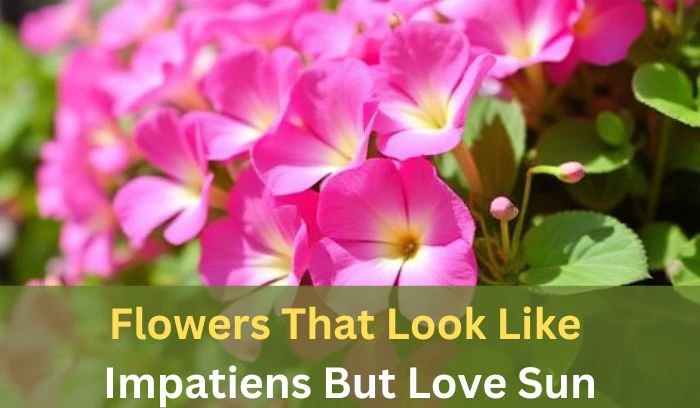
If you love the vibrant look of Impatiens but need something that thrives in a sunny spot, you’re in luck. SunPatiens, New Guinea Impatiens, and Zinnias are all great options for adding color to your garden, even in areas with more sunlight than traditional Impatiens can handle. These flowers bring colorful blooms and can handle sun far better, making them perfect for sunny spots that need a touch of beauty.
While these flowers love the sun, they still have the same striking look as Impatiens. So, if you want blooms that stand out and flourish even in the heat, these sun-loving options are worth considering. Whether you’re looking for something to handle more sun or just want a garden that thrives in the sunlight, SunPatiens, New Guinea Impatiens, and Zinnias will fit the bill.
SunPatiens
SunPatiens resemble Impatiens but are built for the sun. These flowers come in bright and bold colors like pink, red, orange, and violet. Unlike regular Impatiens, SunPatiens are larger and grow bigger, thriving in sunny and hot conditions. They can last longer under the harsh sun, making them perfect for bright garden spots where regular Impatiens might struggle.
These flowers have an upright, bushy habit, which makes them a great choice for filling garden beds or containers. They require less water and care, and they thrive with minimal attention, which makes them a fuss-free option for sunny spots. SunPatiens stand out not only for their beauty but also for their toughness, thriving in conditions where many other flowers might falter.
New Guinea Impatiens
New Guinea Impatiens thrive in the sun, though they do appreciate some shade during the hottest parts of the day. These large, colorful flowers are often paired with beautiful, variegated leaves, adding extra beauty to any garden.
They grow best in well-draining soil and need regular watering to stay healthy and vibrant. If you take good care of them, New Guinea Impatiens will bloom brightly throughout the summer, bringing a burst of color to your outdoor spaces.
Their ability to thrive in sunny spots makes them a great choice for gardeners looking for flowers that are similar to Impatiens but can handle more sunlight.
Zinnias
If you’re searching for flowers that resemble Impatiens but thrive in full sun, Zinnias are an excellent option to consider. These hardy plants are perfect for gardens that need flowers capable of handling the heat.
They bloom in vibrant shades of red, orange, and other stunning colors, adding a pop of brightness to any space. Zinnias are particularly great for attracting butterflies, making your garden a lively haven for pollinators. Unlike many delicate blooms, they require little care, and once planted, they thrive without much effort.
These plants are the ideal choice if you want colorful beauty with minimal maintenance. Whether you’re looking for a garden feature that demands little attention or one that consistently blooms throughout the season, Zinnias are your go-to flowers.
Their resilience in the sun and their ability to withstand tough conditions make them a favorite in many gardens. With their vibrant colors and butterfly-attracting qualities, Zinnias certainly live up to their reputation.
Vinca vs. Periwinkle: Are They the Same?
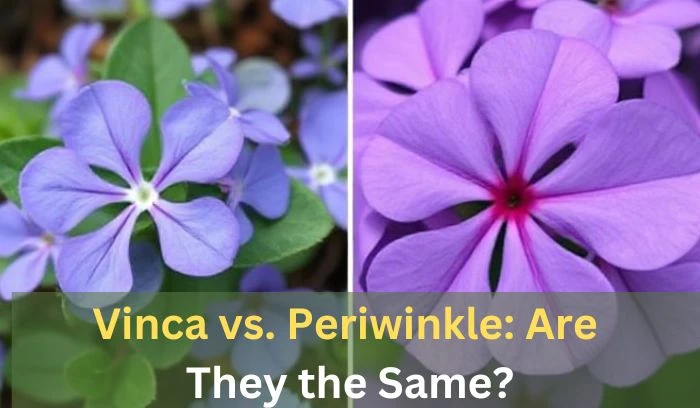
When we talk about Vinca and Periwinkle, we might think they are the same, but the context plays a key role in their differences. Vinca refers to a group of plants, including Vinca major and Vinca minor, which are often called Periwinkle.
These plants are known for being hardy ground covers, meaning they spread quickly across the soil, providing excellent coverage for gardens. However, the term Periwinkle can also refer to the Madagascar Periwinkle (scientifically known as Catharanthus roseus), which is a flowering annual. This plant is widely used for its beautiful flowers and bright colors.
From personal experience, I’ve found that although both Vinca and Periwinkle may share a common name, their uses and characteristics can be very different depending on what you’re looking for in a garden. Whether you’re choosing a ground cover or a colorful flower, understanding their unique features helps in making the right choice for your garden’s needs.
Comparison Table: Vinca vs. Periwinkle
| Feature | Vinca (Catharanthus roseus) | Periwinkle (Vinca major, Vinca minor) |
| Type | Annual or perennial flowering plant | Evergreen ground cover |
| Flowers | Bright blooms: pink, red, white, purple | Small star-like blue or purple flowers |
| Foliage | Glossy, oval-shaped leaves | Dark green, smaller leaves |
| Growth Habit | Upright, spreading, compact | Spreading, forms dense mats |
| Sunlight | Full sun to partial shade | Prefers full shade |
| Use | Garden beds, containers | Ground cover, erosion control |
Differences in Appearance
When it comes to Vinca vs. Periwinkle, the appearance of these plants sets them apart. Vinca has colorful flowers that bloom in shades of pink, red, white, and purple, with single-layered petals and a darker center.
These plants are compact and grow in an upright or spreading habit, making them perfect for borders, garden beds, or pots. The leaves are glossy and oval-shaped, contributing to the plant’s neat appearance.
On the other hand, Periwinkle focuses more on its foliage and ground coverage than its vibrant flowers. The blooms are small, star-like, and typically blue or purple.
Periwinkle spreads along the ground, forming dense mats of greenery, which makes it ideal for shady areas or erosion control. It is a low-maintenance ground cover that thrives in partial shade and prefers rich, moist conditions. Both plants have distinct characteristics that suit different garden needs.
Vinca vs. Petunia: Key Differences
When comparing Vinca and Petunia, the main difference lies in their growth conditions and care needs. Vinca is known for its ability to thrive in heat, sun, and drought conditions, making it a great choice for low-maintenance gardens.
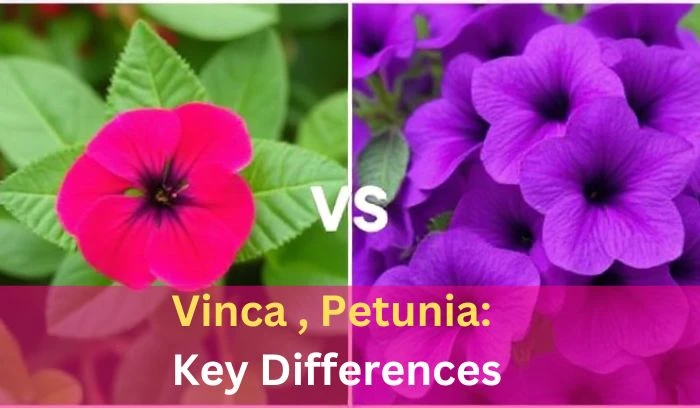
Its glossy leaves and drought-resistant flowers add beauty even in harsh weather. On the other hand, Petunia requires more water and attention to flourish. While they are also colorful garden favorites, Petunias are less heat-tolerant than Vinca and bloom in a wider range of shapes and colors.
In terms of maintenance, Vinca can handle the sun’s heat with little care, making it ideal for gardeners looking for low upkeep. Petunia, while equally beautiful, needs a little more effort to maintain its health and vibrant flowers. Whether you want a low-maintenance option or a plant with a diverse range of blooms, both plants have their place in the garden.
Comparison Table: Vinca vs. Petunia
| Feature | Vinca | Petunia |
|---|---|---|
| Flowers | Single-layered with 5 petals | Trumpet-shaped with ruffled edges |
| Colors | Pink, red, white, purple | Almost every color, including stripes |
| Foliage | Glossy, oval leaves | Soft, hairy leaves |
| Sunlight | Full sun to partial shade | Prefers full sun |
| Water Needs | Drought-tolerant, occasional watering | Needs regular watering |
| Use | Borders, beds, containers | Hanging baskets, beds, containers |
Differences in Appearance
When comparing Vinca and Petunias, their appearance offers some key differences. Vinca has simple, flat flowers with five petals, often in solid colors like pink, red, purple, and white. Its glossy, oval leaves give it a polished, neat look. Vinca tends to grow upright or spreads slightly, making it an ideal choice for borders or small garden spaces.
On the other hand, Petunias have a more dramatic appearance, with trumpet-shaped flowers that feature ruffled or fringed edges. Their variety of colors, including stripes, patterns, and multi-tones, adds a vibrant touch. The soft, hairy leaves give Petunias a more delicate appearance compared to the sleek look of Vinca.
Growing Conditions
Vinca thrives in full sun and is a low-maintenance plant. It handles heat very well and requires little watering once it is established. It grows best in well-draining soil, making it perfect for sunny spots where other plants might struggle. Vinca doesn’t need a lot of care, which is why it’s a great choice for low-effort gardening.
On the other hand, Petunias prefer full sun as well, but they require rich, moist soil and need regular feeding to keep their blooms vibrant. While Petunias can handle some heat, they don’t tolerate drought or extreme heat as well as Vinca, so they need more attention and care to thrive.
Petunias love the sun but need a little more nurturing to grow and flourish, especially in areas with less-than-ideal soil conditions. If you’re looking for a plant that thrives with minimal effort, Vinca is a great option, while Petunias may need extra care to feed and maintain their vibrant appearance throughout the season.
FAQs
Impatiens and vinca are both popular for their colorful flowers, but they handle summer conditions differently. Impatiens struggle in hot, dry weather and can wither, while vinca thrives in intense heat, making it a favorite choice for southern gardens. If you’re looking for a plant that can endure the heat, vinca is the better option.
Vinca plants thrive with gorgeous color until mid fall, but once cold weather arrives, they’re done. They look best when planted in mass or in a colorful pot for a bold burst of flowers. Typically, they last through the warmer months, offering vibrant blooms until the chill sets in.
Vinca plants come in annual and perennial varieties. Annual vincas (Catharanthus roseus) need to be replanted each year, while perennials like Vinca minor and Vinca major last for many years. Vinca minor is a low-growing ground cover, and Vinca major is larger and forms a mounding cover. These perennials can be invasive, spreading beyond their planted area.
For a permanent plant, go for perennial vincas, which grow year after year, unlike the annual vincas that need replanting each season.
The impatiens plant goes by several names, such as jewelweed, touch-me-not, and snapweed in North America. The name jewelweed is often used for Nearctic species, while balsam refers to the tropical species. Another common name is patience, which highlights its ability to thrive in various conditions.
I often hear people call it touch-me-not, as the flowers tend to snap open when touched, making it a popular choice for gardens.
Impatiens last longer with regular watering. If they become leggy, simply prune by pinching the top 1/3 of the growth. This encourages more blooms and will have them repaying you without delay. They won’t quit easily if properly cared for.
Conclusion
When deciding between Vinca and Impatiens, it’s essential to consider your garden conditions and how much care you’re able to provide. Vinca is a great choice for sunny, dry spots, as it thrives with minimal watering and requires little maintenance. With its glossy leaves and bold, single-layered flowers, it’s perfect for low-maintenance gardens.
On the other hand, Impatiens do better in shady, cool areas, needing regular moisture to thrive. Their lush, multi-petal blooms come in a wide range of colors, making them ideal for adding vibrant color in shaded corners. While both can brighten up your garden, Vinca is easier to maintain and works well in dry, sunny spots.


